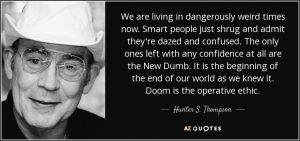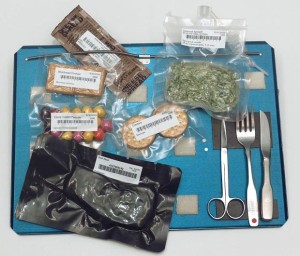Shayla Love of The Washington Post reports that in 2006, Cheryl Nickerson sent a culture of Salmonella for a ride on the space shuttle Atlantis. Eleven days later, she watched anxiously from the Kennedy Space Center in the dead of night as her bacteria returned safely.
 Nickerson, a microbiologist at Arizona State University, and her team then infected hundreds of mice with the salmonella grown in space. At the same time, they infected hundreds of other mice with salmonella simultaneously grown on the ground. They had to work quickly before the bacteria lost the effects of space; it took them about three hours from the time the shuttle landed.
Nickerson, a microbiologist at Arizona State University, and her team then infected hundreds of mice with the salmonella grown in space. At the same time, they infected hundreds of other mice with salmonella simultaneously grown on the ground. They had to work quickly before the bacteria lost the effects of space; it took them about three hours from the time the shuttle landed.
“You get one chance to get it right,” Nickerson said. “We moved lightning fast.”
After a few days, more of the mice with space-grown salmonella were getting sick. Normally, salmonella can kill a mouse in about seven days. The mice given the space salmonella started to die two days earlier, and at lower doses than normal.
It was the first time someone had definitively showed that bacteria became more dangerous after spaceflight.
It has been known for decades that something happens to microbes that leave planet Earth. Sometimes they grow faster and get better at causing disease. Just as often they do the opposite; slowing down and becoming less harmful. The biggest risk, experts say, is that the behavior is unpredictable. And when you send people to space — people who are teeming with microbes — there’s little room for surprise.
Bacteria were some of the first life-forms sent into space. In 1960, a Russian satellite brought E. coli, Aerobacter aerogenes, and Staphylococcus into orbit and concluded that those organisms could live in microgravity. Over the next 50 years, NASA and other spaceflight programs discovered that not only could bacteria survive, sometimes they thrived.
In 2011, Mark Ott, a microbiologist at NASA’s Johnson Space Center, found that Staph aureus grown in a bioreactor that simulates zero gravity appeared less virulent, though it increased production of biofilm, sticky clumps of bacteria. “It wanted to colonize and live in harmony rather than become a pathogen,” he said. But the responses varied from pathogen to pathogen.
Ott’s job is to keep astronauts safe from infection. “From a health-care perspective, it’s a little nerve-racking,” he said. “I want to be able to generalize about bacteria. I want to be able to say, this is what’s causing it, and this is how we make sure it doesn’t happen.”
Microgravity is a dangerous environment. Astronauts can suffer loss of bone density, radiation poisoning and degraded vision. But many researchers now say that microgravity isn’t what is changing bacteria. At least, not directly.
 Nickerson theorizes that a force called “fluid shear” can explain many of the odd changes. In the body, bacteria are always interacting with liquids like blood, mucous or stomach fluid. These fluids apply a physical force, or shear, on the bacteria’s outer membranes, like the force of water rushing over a rock at the bottom of a riverbed. Nickerson thinks that bacteria feel this shear from their surroundings and use it as a clue to how they should behave. Microgravity happens to be the ultimate low-shear environment.
Nickerson theorizes that a force called “fluid shear” can explain many of the odd changes. In the body, bacteria are always interacting with liquids like blood, mucous or stomach fluid. These fluids apply a physical force, or shear, on the bacteria’s outer membranes, like the force of water rushing over a rock at the bottom of a riverbed. Nickerson thinks that bacteria feel this shear from their surroundings and use it as a clue to how they should behave. Microgravity happens to be the ultimate low-shear environment.
Since 2006, Nickerson has completed five bacteria experiments in space, and she just got funding for two more. In her bioreactors on Earth, which create low-fluid-shear conditions, Nickerson has also been able to replicate many of her results. She has identified one protein, Hfq, that regulates which genes are active in bacteria, and she thinks it may respond to changes in shear.
People share their bodies with trillions of bacteria, and they’re crucial to normal health and functioning. If Nickerson, Ott and others’ work shows that bacteria can behave differently when their physical surroundings change, could it be possible that the bacteria astronauts bring with them to space will be affected?
Hernan Lorenzi, a researcher at the J. Craig Venter Institute, has been studying this very problem. For the past four years, he has collected samples from nine astronauts before, during and after long-duration missions. He is looking at the microbiomes of the nose, mouth, skin and gut to see what happens after spaceflight. He expected decreases in each area, since the environment was so sterile. In the nose, he was right. But in the gut, several strains of bacteria proliferated, and others decreased.
It’s unclear what this would mean for human health. Several of the bacteria that are changing help prime the immune system. It’s also been well documented that the immune system is compromised in space. Lorenzi worries that an astronaut will be more vulnerable to disease.
 Chia-Yi Hou of Changing America writes the researchers found that there were changes in RNA and protein expression in the human cells in a microgravity environment. They also found that salmonella was able to cause the human cells to upregulate — increase the rate or level of — expression of compounds that would help fight an infection in both cells that were inflight and on the ground.
Chia-Yi Hou of Changing America writes the researchers found that there were changes in RNA and protein expression in the human cells in a microgravity environment. They also found that salmonella was able to cause the human cells to upregulate — increase the rate or level of — expression of compounds that would help fight an infection in both cells that were inflight and on the ground.


